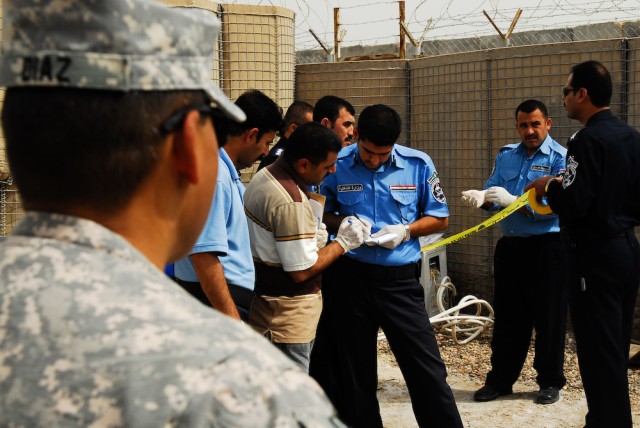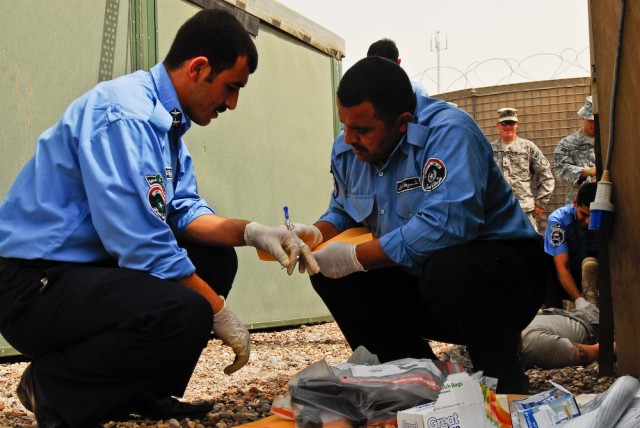BASRA, Iraq - A training case that seems like an open-and-shut suicide quickly reveals itself to be a homicide as members of the Iraqi Police use the skills they learned during a two-week course taught by the 203rd Military Police Battalion on dissecting a murder scene.
Soldiers from the 203rd MP Bn., along with law enforcement professionals Donnie Weller and David Diaz, held a two-week evidence collection course at the Provincial Joint Coordination Center in Basra, Iraq, designed to implement standardized evidence collection procedures for the IP.
The training led to a final evaluation of a crime scene investigation held at the Iraqi Police Training Center on Contingency Operating Base Basra.
Two identical containerized housing units served as the murder sites, while two Soldiers from the 203rd MP Bn. posed as victims. As the IPs broke into two groups and delegated responsibilities, things appeared typical until they began assessing the scene.
"The first thing I did was check the victim to see if he was still alive. After concluding that he was dead, I began piecing together the evidence," said Capt. Mushtak Nuri Abbas, an IP team leader with the Crime Scene Investigation Team.
"At first it looked like a suicide, but things just didn\'t add up: the placement of the weapon, the handwriting in the suicide note that didn't match the hand writing on other documents, a faint trail leading back into the room and a set of bloody fingerprints outside the door," said Abbas.
Diaz said that they strategically placed 10 critical pieces of evidence throughout each crime scene the IPs had to find to deduce the cause of death.
"The evaluation was a bit harder than we expected," said Abbas. "We had to rely on the training we learned in order to solve the scenario. This course was a tremendous help."
In November, the Basra Provincial Reconstruction Team and 17th Fires Brigade Rule of Law team brought local judges and police together for the first time when they arranged a conference at the Basra Palace of Justice. The conference opened the lines of communication between the two.
During the conference, Chief Judge Khaz'al Da'bol Qasim said only by working together would the judges and the police be able to assess the system and implement a strategy.
Earlier this year, the two sides met with the intention of learning what each side required to ensure a better judiciary process. With the help of law enforcement professional Edgar Lacy, assigned to the 17th FiB ROL team, the judges and police were able to solidify a standard for admissible evidence.
"Everything depends on collecting the right evidence at the crime scenes," said Lacy.
Based off the feedback from the second meeting between the IP and judges, the 203rd MPs began developing a curriculum.
"Our goal was to not only teach the IPs standardized evidence collection procedures, but to make sure they implemented those techniques in their routine," said Sgt. Brandon Teague, a 203rd MP Bn. team leader.
The two-week course focused on tagging and documenting evidence, quarantining a crime scene, collecting evidence and collecting witness statements.
"Everyone at the crime scene is a potential suspect, so it's important to make sure you question them thoroughly, because they may turn out to be involved," Weller said.








Social Sharing